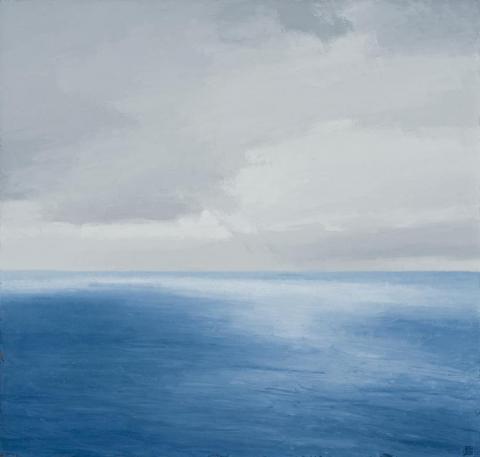SECOND LUCID INTERVAL, 2003
Philip Wolfhagen
oil and beeswax on linen
200.0 x 210.0 cm
signed with artist's monogram lower right
signed with initial, dated and inscribed lower right: W /Sept 25 / 2003 / “Second / lucid / interval”
inscribed verso: “Second lucid interval” 2003 / oil and beeswax on linen / 200 x 210 cm
Christine Abrahams Gallery, Melbourne (label attached verso)
Private collection, Victoria
During 2003 Philip Wolfhagen completed a monumental canvas of sixteen metres. It was the result of a two week artist residency on Deal Island, a rugged piece of land run by the Parks and Wildlife Service in the middle of Bass Strait between Flinders Island and mainland Australia. 'Wolfhagen has said after the intense physicality of Deal Island and Archipelago experience he wanted to paint nothing but vapour and fluid. These pictures (Lucid Intervals 2003) suggest such ambiguity, such intangibility, such freedom.'1 The 'Lucid Interval' paintings show a distinct shift away from the more topographical works of 2000/02, to a more abstract sensibility. 'There seems to be no terrestrial physics in operation here, just the light of expectation, the weight of a pause.'2 The gentle moody ambience of Second Lucid Interval, 2003, with its soft luminosity, is reminiscent of the spiritual abstractions of American painter Mark Rothko. It is a challenge for Australian landscape painters to interpret subjects with no apparent physical focal point, as Fred Williams once said we are so conditioned to seeing our natural surroundings in ways that generations of artists and photographers have taught us to see them that our vision has become selective.3 Philip Wolfhagen's vision is highly selective, he has singularly chosen to interpret and re-interpret the Tasmanian terrain of land, sea and sky. 'His paintings of the sea, and his bare windswept hillsides, while acknowledging a debt to Fred Williams, extend his vision into territories, both geographic and artistic.'4 Wolfhagen is one of Australia's most celebrated contemporary landscape painters. He was awarded the Wynne Prize for landscape painting in 2007 and received a Centenary Medal for his contribution to the arts (2001).
1. Hansen, D., 'To earth return', Art and Australia, vol. 42 No. 1, Spring 2004, p. 94
2. ibid., p. 94
3. Fred Williams as quoted in Timms. P., Philip Wolfhagen, Craftsman House, Melbourne, 2005
4. ibid., p. 33
Philip Wolfhagen is represented by Karen Woodbury Gallery, Melbourne
